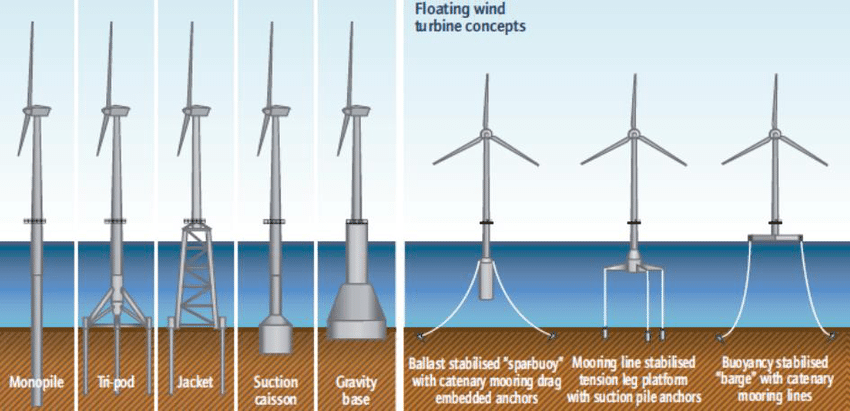Wind offshore
Definition^1 : Offshore wind power or offshore wind energy is the use of wind farms constructed in bodies of water, usually in the ocean, to harvest wind energy to generate electricity. Higher wind speeds are available offshore compared to on land, so offshore wind power’s electricity generation is higher per amount of capacity installed,and opposition to construction is usually much weaker.
Offshore electricity production, through wind farms can be split in two contruction types: - offshore fixed-bottom - offshore floating
Fixed bottom foundations and floating offshore concepts^2

Wind is split into 14 class (speed class m/s).
A wind farm is not producing electricity full time, in order to model yearly production a variable is set : Capacity Factor (%).
Capacity factor^3 : Generally defined as the ratio of actual annual output to output at rated capacity for an entire year.
Data
Most of the data used for this model is extracted from International Energy Agency (IEA)^4, International Renewable Energy Agency (IRENA)^5, Global Wind Energy Council (GWEC)^6 and National Renewable Energy Laboratory (NREL)[^7].
Some IRENA data

Some insight on Wind offshore evolution
IEA Offshore power generation prediction
^2: IOPscience, 2016, Wind turbines: current status, obstacles, trends and technologies, https://iopscience.iop.org/article/10.1088/1757-899X/161/1/012079 ^3: Capacity factor. NRC.gov, https://www.nrc.gov/reading-rm/basic-ref/glossary/capacity-factor-net.html ^4: IEA 2022, Wind, https://www.iea.org/fuels-and-technologies/wind, License: CC BY 4.0. ^5: IRENA (2020), Future of wind 2019, International Renewable Energy Agency, Abu Dhabi. https://www.irena.org/-/media/Files/IRENA/Agency/Publication/2019/Oct/IRENA_Future_of_wind_2019.pdf ^6: Global Wind Energy Council (GWEC), Global wind report 2019, https://gwec.net/global-wind-report-2019/ [^7]: National Renewable Energy Laboratory USA (NREL), Annual Technology Baseline 2020, https://atb.nrel.gov/electricity/2020/data.php